
Still Light with Bright Lights - 30 x 25 cm - Oil on Board

Summer Days at Lesceave, Cornwall - 100 x 102 cm - Oil on Canvas

Orange Juice and Plums - 25 x 30 cm - Oil on Board

Opening the French Windows, Polgrean - 100 x 100 cm - Oil on Canvas

Two Tables of Flowers - 30 x 25 cm - Oil on Board

Late Afternoon, St Ives School of Painting - 30 x 25 cm - Oil on Board

Wild Weather, St Ives School of Painting - 30 x 25 cm - Oil on Board
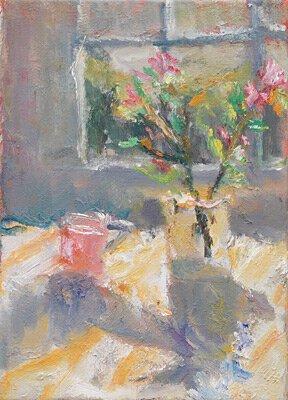
Apple Blossom in the Window with the Pink Cup - 35 x 25 cm - Oil on Canvas

Cornflowers and the Emerald Green Cloth - 35 x 25 cm - Oil on Canvas

Bright Lights and White Table Cloth - 25 x 30 cm - Oil on Board

Chair and Two Blues - 32 x 25 cm - Oil on Canvas

Cobalt and Violet Blue Shadows - 25 x 35 cm - Oil on Canvas

Roses by the Open Door - 25 x 30 cm - Oil on Canvas

The Emerald Green Cloth - 40 x 40 cm - Oil on Canvas

The Olive Tree in a Cloudless Sky - 61 x 51 cm - Oil on Canvas
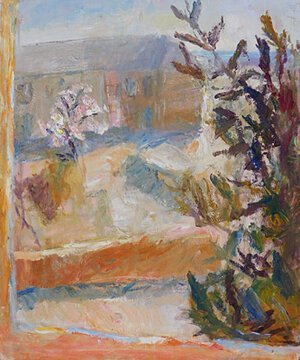
Cherry Blossom in Early Morning May Light - 51 x 61 cm - Oil on Canvas

The Yellow and Striped White Cloth and Lemons in a Glass Bowl - 51 x 61 cm - Oil on Canvas

Spring Flowers Against the Light - 51 x 61 cm - Oil on Canvas

Olive Tree Shadows, Polgrean - 50 x 50 cm - Oil on Canvas
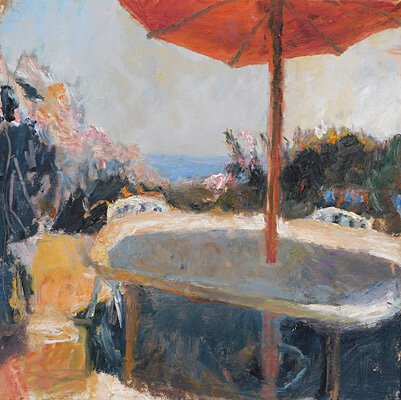
Summer Heat on the Patio, Lesceave, Cornwall - 50 x 50 cm - Oil on Canvas

Anemones in the Window, Portscatho - 50 x 50 cm - Oil on Canvas

The Kitchen Table, Polgrean - 50 x 50 cm - Oil on Canvas

Summers Day, Lesceave, Cornwall - 60 x 60 cm - Oil on Canvas

Oranges, Lemons and the Green Glass Jug - 50 x 50 cm - Oil on Canvas
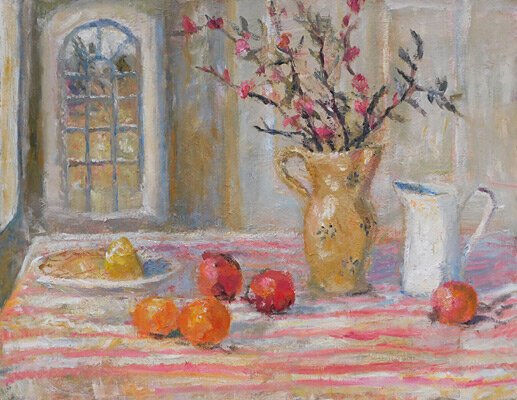
The Window Upstairs, Polgrean - 71 x 91 cm - Oil on Canvas

The Provencal Jug and Two Yellows - 61 x 76 cm - Oil on Canvas

French Windows and Red Table Cloth - 71 x 91 cm - Oil on Canvas

Lunch Outside with the Indian Tablecloth - 71 x 91 cm - Oil on Canvas

Spring Awakening - 76 x 61 cm - Oil on Canvas

Frost and Early Morning Sun - 76 x 61 cm - Oil on Canvas

Rosehips in the Studio Window, Polgrean - 76 x 61 cm - Oil on Canvas

The Studio Room with Mirror - 76 x 61 cm - Oil on Canvas

The Pink and White Edged Plate and Mirror - 61 x 76 cm - Oil on Canvas
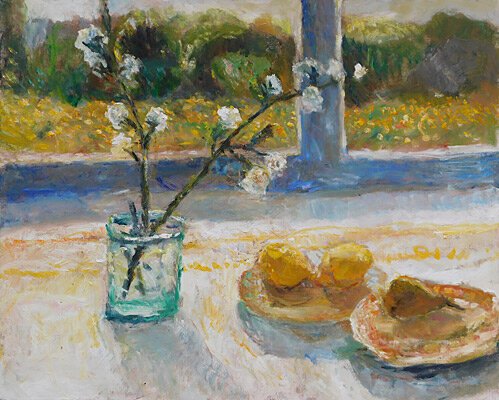
Roses and a Field of Buttercups, Polgrean - 61 x 76 cm - Oil on Canvas
There is in all of Alice Mumford’s work a focus on light’s capacity to animate, for light is her essential subject. First and foremost a colourist, her eye is keenly attuned to the physical and sensory effects of colour, its chromatic variations and interactions, and to the ways in which the eye navigates and makes sense of both objects and space, its comprehension informed by the quality and play of light. The artist’s motifs of still life and landscape stem from her surroundings; the stuff of her everyday life, transformed in paint to conjure something that speaks of both permanence and transience. Her work reflects the seasons. Here, Summer Heat on the Patio, Lesceave, Cornwall summons the optical effects of high summer, the way that motes swim and things momentarily appear to shimmer and dissolve as one narrows one’s gaze as it moves from shadow towards the glare of the sun. Frost and Early Morning Sun is equally though differently dramatic, its raked wintry light causing long bluish shadows whilst making hues in a bowl of fruit sharper. Elsewhere, the drama of light and colour relationships is gentler, more nuanced, particularly in domestic still life arrangements such as The Pink and White Edged Plate and Mirror, in which the interplay between a still life and its reflection creates a picture within a picture, the inflected whites of tablecloth and mirror frame merging the two.
Amongst Mumford’s most admired painters are Matisse and Cézanne, though it is with Bonnard that she feels the closest kinship. She sometimes makes painted copies from works by other artists in an attempt to understand them more deeply, and recently made a copy of Bonnard’s ‘The Dining Room at Le Cannet’ (1932). Subsequently, she recounted how it was only upon realising that she had omitted from her canvas a small patch of blue that Bonnard had painted near to the centre of his tabletop still life that it dawned on her that this was the very thing that held everything in place:
“I had pretty much finished the copy, and began to think that the mysteries of how this painting worked were impenetrable. Then I realised I had omitted the small, blue, diagonal rectangle, that adjoins the large orange rectangle in the middle of the canvas. Without this dark blue chip, the structure of the space seemed to fall apart. Not only does it provide a way into the picture, as the point of most contrast, but it also brightens all the whites, oranges and yellow-oranges, creating this incredible bouncing light.”
We cannot be certain whether Bonnard invented this anchoring fragment, or painted it from a carefully chosen object: it was though clearly fundamental to his pictorial stratagem. And it is insights such as this, into the often-complex architecture of shape and colour involved in picture making, which inform and underpin Mumford’s work. There is for instance a not dissimilar patch of colour to that of the Bonnard in her Summer days at Lesceave; a centrally placed blue-black strip that describes the edge of a dish or book set on a table positioned out of doors, and that marks a point in space between the blacks within a vase of flowers in the foreground and those in a group of shrubs set further back against sea and sky. One realises that here too this ostensibly minor component is fundamental to the creation of pictorial space. This painting and Opening the French Windows, Polgrean – the two largest and most complex canvases here – each consist of a sequence of interconnected interior and exterior spaces, in which a room is bathed in warm light, light which flows through a curtained open doorway that acts as a proscenium linking inside and outside worlds.
The artist has said before how important tempo is in her painting, referring to the rhythm and pace of application of pigment to canvas. She employs a wide vocabulary of mark, sometimes put down with deliberative forethought; sometimes more spontaneously, with concentrated speed. In some works one senses the scrabbling of the brush in its quest to pin down a transitory effect, the paint scurried on in impasto or dry-brush. This certainly applies to certain of the small still life canvases shown here, all of them essays in pure painting; Apple blossom in the window with The Pink Cup and Bright Lights and White Table Cloth are amongst prime examples. Elsewhere, in works such as the lyrical The Olive Tree in a Cloudless Sky, the handling is softer, more delicate and restrained. Throughout, Mumford elicits an unforced poetry, one that stems from her deep commitment to the craft of painting, and a continuing fascination with colour and light.